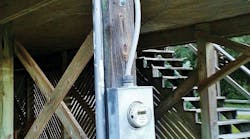How well do you know the Code? Think you can spot violations the original installer either ignored or couldn't identify? Here's your chance to moonlight as an electrical inspector and second-guess someone else's work from the safety of your living room or office. It's your turn to identify the violation.
Hint: Arranged to drain
March Winner
Our lone winner this month was Shauwn Collins, owner, Absolute Electric LLC, Sterling, Va. He properly noted that these receptacle outlet covers are not the “in use” type required by the NEC. The location in which they were installed is also a concern.
These receptacles supply power to some ice-melting cables installed in the gutter, downspouts, and on the roof of this building. The covers installed on these boxes are not the right type for the 125V, 15A receptacles being used at this outdoor wet location. According to the requirements in Sec. 406.9(B)(1), in this type of location the enclosure must be weatherproof whether or not the attachment plug is inserted. These covers are only weatherproof when they are closed. In addition, the receptacles themselves must be listed as weather-resistant type. According to Exception No. 2 of Sec. 210.8(B), these receptacles are not readily accessible and would not need GFCI protection. However, the listing instructions for these cord- and plug-connected electric ice melting cables generally require ground fault protection.






